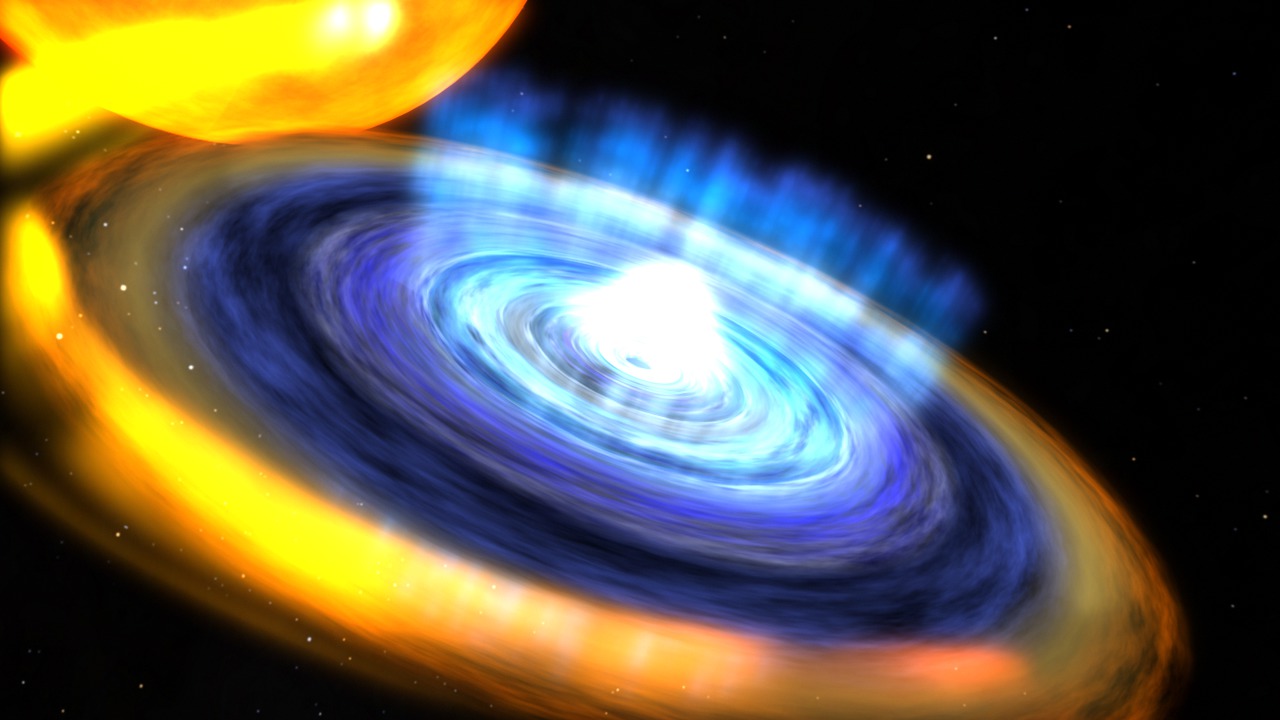RXTE Detects 'Heartbeat' Of Smallest Black Hole Candidate
Data from NASA's Rossi X-ray Timing Explorer (RXTE) satellite has identified a candidate for the smallest-known black hole. The evidence comes from a specific type of X-ray pattern — nicknamed a "heartbeat" because of its resemblance to an electrocardiogram — that until now has been recorded in only one other black hole system.
Named IGR J17091-3624 after the astronomical coordinates of its sky position, the binary system pairs a normal star with a black hole that may weigh less than three times the sun's mass, near the theoretical boundary where black-hole status first becomes possible. Flare-ups occur when gas from the normal star streams toward the black hole and forms a disk around it. Friction within the disk heats the gas to millions of degrees, which is hot enough to radiate X-rays.
The record-holder for ubiquitous X-ray variability is another black hole binary named GRS 1915+105. This system is unique in displaying more than a dozen highly structured patterns — typically lasting between seconds and hours — that scientists distinguish by Greek-letter names. Seven of these patterns are now seen in IGR J17091, including the so-called rho-class oscillations that astronomers describe them as the "heartbeat" of black hole systems.
It's thought that strong magnetic fields near the black hole's event horizon eject some of the gas into dual, oppositely directed jets that blast outward at nearly the speed of light. The peak of its heartbeat emission corresponds to the emergence of the jet. Changes in the X-ray spectrum observed by RXTE during each beat in GRS 1915 reveal that the innermost region of the disk emits enough radiation to push back the gas, creating a strong outward wind that staunches the inward flow, briefly starving the black hole and shutting down the jet. This corresponds to the faintest emission. Eventually the inner disk gets so bright and so hot that it essentially disintegrates and plunges toward the black hole, re-establishing the jet and beginning the cycle anew.
In GRS 1915+105, which at 14 solar masses is by for the more massive of the two, this cycle can take as little as 40 seconds. In IGR J17091, the emission can be 20 times fainter than GRS 1915, and the heartbeat cycle can occur up to eight times faster.
Download the animations here.
This animation compares the X-ray 'heartbeats' of GRS 1915 and IGR J17091, two black holes that ingest gas from companion stars. GRS 1915 has nearly five times the mass of IGR J17091, which at three solar masses may be the smallest black hole known. A fly-through relates the heartbeats to hypothesized changes in the black hole's jet and disk.
For complete transcript, click here.

Print resolution version of still from video

Artist's rendering showing the black hole and its accretion disk before the jet emerges.

Artist's rendering showing the jet fully established.

Artist's rendering showing the onset of the disk wind, which shuts down the jet.

Artist's rendering showing the disk wind fully established.
Video with captions translated into Dutch.
Video with captions translated into Italian.
Video with captions translated into Spanish.
For More Information
Credits
Please give credit for this item to:
NASA/Goddard Space Flight Center/CI Lab
-
Animators
- Walt Feimer (HTSI)
- Tyler Chase (UMBC)
-
Video editor
- Scott Wiessinger (USRA)
-
Producer
- Scott Wiessinger (USRA)
-
Writer
- Francis Reddy (Syneren Technologies)
Missions
This page is related to the following missions:Series
This page can be found in the following series:Tapes
The media on this page originally appeared on the following tapes:-
Black Hole Heartbeat
(ID: 2011124)
Monday, December 12, 2011 at 5:00AM
Produced by - Robert Crippen (NASA)
Release date
This page was originally published on Thursday, December 15, 2011.
This page was last updated on Wednesday, May 3, 2023 at 1:53 PM EDT.
